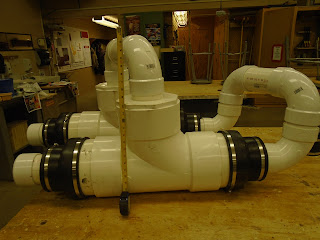Location: Logan HS
Time: 3 hours
Goal: Fabricate the support structure we are calling the condenser module that will house the two radiators.
We worked on the "condenser module" today and got it roughed out. This took a while to fabricate as it had lot of angles and special cuts.
We used some 6" PVC pipe as supports and may put a couple more supports on the sides. The module has some temporary screws to hold the plexiglass in place as the silicon on the top cures. The bottom piece of plexiglass is not glued in anyway (just a couple of screws holding it in place) in case we need to modify. We will put the radiators in and get everything secured with silicon later.
No holes are drilled in the top plexiglass for airflow to get to the bottom radiator yet except for one for the radiator hose to go down through. We are still determining the size of the holes and how many we need. We want the warm air flow to move through the top radiator and then to the lower one to increase the amount of condensation that we hope will occur.
We will use a Dremel tool later to cut a hole in the bottom plexiglass to allow water to run down to the collection unit.
Next objective is to begin work on the evaporator module.
 |
| Revised sketches of what we thought could work as a condenser module. This led us to our current design. |
 |
| More sketch ideas on the condenser and evaporator units. |
 |
| Raw material being measured and cut out. |
 |
| Second piece of plexiglass was cut out and PVC pipe was cut at angles. |
 |
| View from the side with the PC radiator we are planning to use. |
 |
| Top view of radiator. |
 |
| Side view of roughed out condenser module. When installed in the pipe, it will give our radiators the angle we want to maximize condensation. |






















